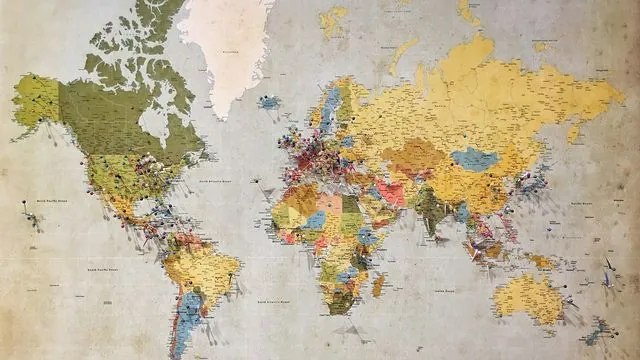
Revolutionary New Tool Unveils the Dynamic Journey of Human Ancestry
2025-03-28
Author: Siti
Revolutionary New Tool Unveils the Dynamic Journey of Human Ancestry
In an exciting breakthrough, researchers at the University of Michigan have developed a cutting-edge statistical method that not only tracks human ancestry across time but opens up new dimensions in understanding various biological phenomena, including disease spread and animal migration.
Led by Gideon Bradburd, a professor in ecology and evolutionary biology, this innovative approach offers an illuminating perspective on our ancestry. When you receive a personalized DNA report, it often presents a limited snapshot of your family lineage at a specific place and time. For instance, if your report indicates that you are 50% Irish, it suggests a connection to a network of relatives currently residing in Ireland. However, Bradburd emphasizes that genealogical histories are far more fluid and complex than such reports suggest, resembling a dynamic "movie" rather than a static image.
The groundbreaking statistical method, designed by Bradburd along with fellow researchers Michael Grundler and Jonathan Terhorst, leverages contemporary genetic sequences to provide a comprehensive view of ancestry. This includes tracing the origins of our ancestors and visualizing their movements across the globe over centuries. By estimating the geographical locations of genetic ancestors and how human populations historically migrated, the researchers have ushered in a new era of genealogical mapping.
But the significance of this method extends beyond understanding our ancestry. It has powerful implications for tracking disease outbreaks, understanding the emergence of viruses, and analyzing the diversity within animal populations. Their pioneering findings have been published in the esteemed journal Science.
As Bradburd explains, traditional ancestry reports have their merits, particularly for individuals who have lost contact with their familial roots. However, they can inadvertently reinforce outdated notions of race by presenting categories—such as "Irish"—as fixed and unchanging entities. He argues that such representations oversimplify the complexities of human ancestry, which is anything but static.
Thanks to advancements in genetic research, particularly through the work of Nobel laureate Svante Pääbo, scientists can now genotype ancient DNA, allowing for a more nuanced understanding of human population spreads. This research reveals the fluidity of genetic identities over time, making it clear that trying to define what it means to be "Irish" or belonging to any ethnic group is a misguided endeavor.
Bradburd reminds us of a compelling thought experiment: if you trace your ancestry back through just a few generations, you will find that the number of your direct ancestors quickly exceeds the current global population. This interconnectedness among all of humanity speaks to our shared history and reinforces the concept that we are all closely related.
While ancestry reports can be accurate for specific timeframes, Bradburd urges users to look beyond a single moment in history. In fact, he asserts that tracing back far enough, one could just as correctly claim to have 100% African ancestry, as modern humans originated from Africa.
The newly coined statistical method, dubbed Gaia (geographic ancestry inference algorithm), operates on a fundamental premise: individuals tend to migrate locally. By integrating this assumption with data on current populations and a genetic framework called the ancestral recombination graph, researchers can discover the most probable locations of ancestors and derive a timeline of migrations.
The implications of this research are vast. It challenges the scientific community to minimize race-based descriptors that do not accurately reflect the genetic diversity within populations. While it is important to understand the social aspects of race, these categories can mislead and oversimplify genetic variation.
Bradburd’s team is also applying the Gaia method to other fields outside of human genetics. The technique can help analyze the dispersal patterns of various organisms, from diseases to animals, across different geographical areas.
For instance, collaborative efforts with Australian researchers are focusing on the colonization patterns of mosquitoes in the South Pacific. Meanwhile, studies in conjunction with Michigan and Ohio scientists aim to unravel the dispersal history of the Massasauga rattlesnake.
As Bradburd enthusiastically concludes, this methodology underscores the fluidity of ancestry timelines. Our understanding of ancestry should be dynamic, evolving, and rich—like a movie that captures the depth and breadth of human history rather than a still photograph.
This revolutionary tool isn't just about tracing roots; it's about grasping the intricate and continuously unfolding narrative of our shared existence.

 Brasil (PT)
Brasil (PT)
 Canada (EN)
Canada (EN)
 Chile (ES)
Chile (ES)
 Česko (CS)
Česko (CS)
 대한민국 (KO)
대한민국 (KO)
 España (ES)
España (ES)
 France (FR)
France (FR)
 Hong Kong (EN)
Hong Kong (EN)
 Italia (IT)
Italia (IT)
 日本 (JA)
日本 (JA)
 Magyarország (HU)
Magyarország (HU)
 Norge (NO)
Norge (NO)
 Polska (PL)
Polska (PL)
 Schweiz (DE)
Schweiz (DE)
 Singapore (EN)
Singapore (EN)
 Sverige (SV)
Sverige (SV)
 Suomi (FI)
Suomi (FI)
 Türkiye (TR)
Türkiye (TR)
 الإمارات العربية المتحدة (AR)
الإمارات العربية المتحدة (AR)